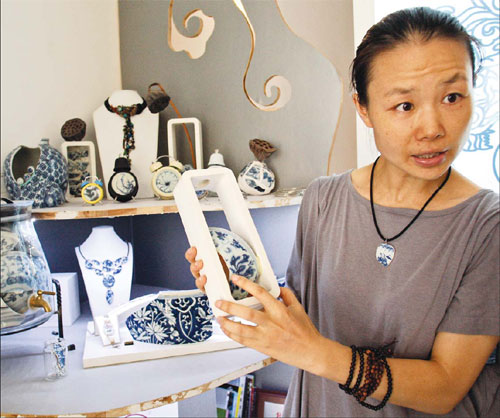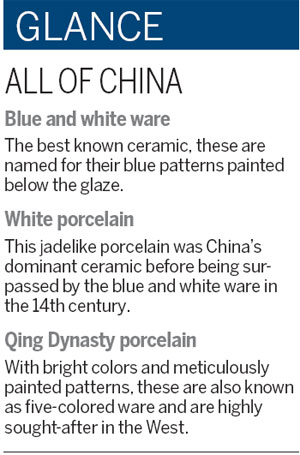Piecing it all together
Updated: 2012-08-24 09:17
By Sun Yuanqing (China Daily)
|
|||||||||||
|
Wu Mei says by wearing the aged porcelain, people are actually wearing a part of Chinese history. Zhang Wei / China Daily |
Artists, craftsmen find new meaning in forgotten shards of China
Piles of porcelain shards line the wall of Wu Mei's workshop. Covered in dirt and stacked in plastic boxes, they could easily be mistaken for trash. But through a process of selecting, pairing and adorning, these broken pieces of china are being fashioned into pendants and necklaces that can command prices into the tens of thousands of yuan. "They can be chic and classic at the same time. Every piece is different as there are never two of the same pieces with exactly the same pattern," says Wu Mei, founder and manager of Maeya Porcelain Shop.
Chinese jewelry, such as Wu's china creations, is becoming increasingly popular among fashionistas and savvy buyers for its look and vintage value. Various stores selling these items, both brick-and-mortar and online, have sprung up in the past few years.
"I don't really care about how much money I can make. The point is to share the beauty and the history behind the porcelain," Wu says.
Porcelain originated in China. Countless amounts of porcelain scraps and shards in the country - many in historic cities like Beijing and Xi'an - have been discarded, buried and forgotten since ancient times. But a lot of these are now being dug out and discovered as these metropolises urbanize.
Collectors and craftsmen are tapping into the "bonanza", where much of the china is also finding its way into interior decoration.
Popular wares include those from the Ming (1368-1644) and Qing (1644-1911) dynasties, when high-quality porcelain was produced in large quantities. The patterns on the porcelain of the Ming look blurred and unaffected, while those from the Qing are more delicate and sophisticated.
"Compared with modern porcelain, they fragment better," Wu says. "It's also a very good way to recycle the resources."
A former college English teacher, Wu quit her job and followed her passion for the antiques six years ago. A frequent visitor to Beijing's Panjiayuan and Baoguosi antique market, she was constantly amazed by the exquisite art of the old times.
"Although broken, they can be stunning when fashioned into pendants and necklaces," Wu says of the china.
To explore the idea of reusing the shards, Wu turned to major Chinese online shopping site Taobao.com. Making these porcelain pieces into jewelry soon gained popularity among online buyers and similar stores sprung up. Today, such stores can be found in old Beijing spots, including the Nanluoguxiang and Houhai areas, as well as in shopping malls.
Much to Wu's surprise, her products won a "Beijing Gift" gold medal from the Beijing Tourism Bureau in 2010 for her creativity and unique designs.
Wu also opened a store in the 798 art zone, the industrial-area-turned-art-district in Beijing. She also has outlets in Guangzhou, Hangzhou and Macao.
Back in her Beijing store, she lays out china scraps and shards from different generations to help educate her customers on the history and culture of porcelain.
She has developed various pieces of jewelry to cater to her customers. Larger pieces of porcelain, lined with silver and gold, are a favorite with older people, while smaller ones decorated with bronze and stones are more popular with the younger generation.
|
|
Some pieces are adorned with the traditional royal handicraft filigree and inlay, adding a sense of extravagance to the simplicity of porcelain.
More than half of Wu's customers are from the United States and Europe. "They prefer the smaller ones like the earrings and the bracelets," she says. "They are easy to carry and relatively affordable, serving well as souvenirs for friends and families."
With more stores joining the fray, many craftsmen are also pushing for more ways to use the china, such as placing it within old-fashioned clocks and fashioning it into buttons to go with plain color cotton and linen.
For some people, porcelain jewelry is not only about beauty but also a good way to learn about the history and culture embedded in the item.
"I use it as a way to get intimate with Chinese history and culture. The stories and history behind these things are just fascinating," says Huang Chuan, founder and owner of Ruyifang, another porcelain dealer concentrating on porcelain lined with filigree and inlays.
"It's not as abstract as what textbooks offer. You can see and tell the traces and different impact each dynasty has on its porcelain art."
As demand and the popularity of porcelain jewelry grow, the porcelain shard market has also grown. Previously, it was very easy to pick out such porcelain pieces with good-looking patterns, but now it takes more time and money as more people are competing for better materials.
"We used to call them 'trash scraps'. They were not of much use. But the wholesale price has been rising during the last few years," says Wang Yaojun, a shard dealer from the Panjiayuan market. "People buy them for jewelry processing, interior decoration or just for studying."
But with such a large repository of china to tap, Wu and others in the know are not so worried. In fact, the future of the market looks bright.
"By wearing the aged porcelain, you are actually wearing a part of Chinese history," Wu says.
sunyuanqing@chinadaily.com.cn
Today's Top News
Rescuers race against time for quake victims
Telecom workers restore links
Coal mine blast kills 18 in Jilin
Intl scholarship puts China on the map
More bird flu patients discharged
Gold loses sheen, but still a safe bet
US 'turns blind eye to human rights'
Telecom workers restore links
Hot Topics
Lunar probe , China growth forecasts, Emission rules get tougher, China seen through 'colored lens', International board,
Editor's Picks

|

|

|

|

|

|







